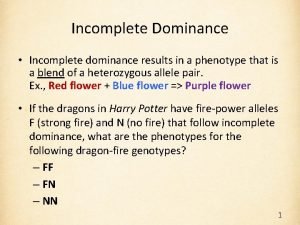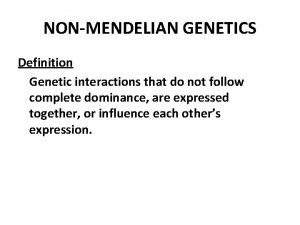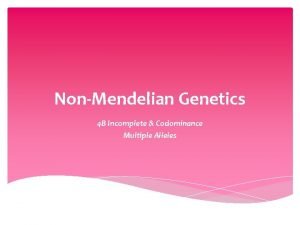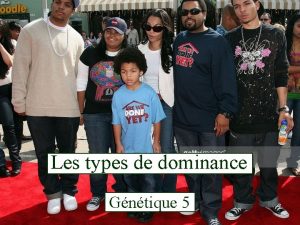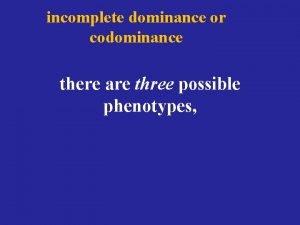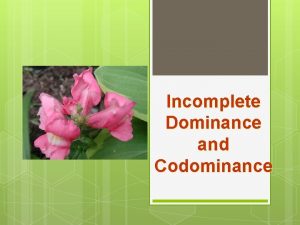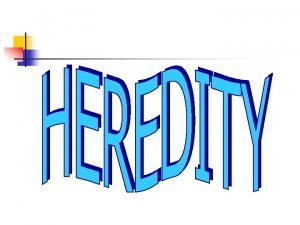Genetics Case Study Mr Nichols PHHS Incomplete dominance










- Slides: 10

Genetics Case Study Mr. Nichols PHHS

Incomplete dominance • • Neither allele is dominant and heterozygous individuals have an intermediate phenotype. For example, in Japanese “Four o’clock”, plants with one red allele and one white allele have pink flowers: 2

P Generation White CWCW Red CRCR Gametes CR CW Pink CRCW F 1 Generation 1⁄ 1⁄ 2 Gametes Eggs 2 CR CR 1⁄ 2 CR Sperm F 2 Generation 1⁄ 1⁄ 2 2 CR CR CW CW CW Cw 3

Incomplete Dominance Gametes CR CW C RC R C RC W CW CW C RC R CR Gametes F 1 generation All CRCW CW F 2 generation CW CW 1: 2: 1 Copyright © The Mc. Graw-Hill Companies, Inc. Permission required for reproduction or display. 4

Codominance • • Neither allele is dominant and both alleles are expressed in heterozygous individuals Example ABO blood types 5

Polygenic Traits • • Most traits are not controlled by a single gene locus, but by the combined interaction of many gene loci. These are called polygenic traits. Polygenic traits often show continuous variation, rather then a few discrete forms: 6

Epistasis • • Type of polygenic inheritance where the alleles at one gene locus can hide or prevent the expression of alleles at a second gene locus. Labrador retrievers one gene locus affects coat color by controlling how densely the pigment eumelanin is deposited in the fur. A dominant allele (B) produces a black coat while the recessive allele (b) produces a brown coat However, a second gene locus controls whether any eumelanin at all is deposited in the fur. Dogs that are homozygous recessive at this locus (ee) will have yellow fur no matter which alleles are at the first locus: 7

Epistasis ee No dark pigment in fur eebb Yellow fur ee. B_ Yellow fur E_ Dark pigment in fur E_bb Brown fur Copyright © The Mc. Graw-Hill Companies, Inc. Permission required for reproduction or display. E_B_ Black fur 8

Pleiotropy • • This is when a single gene locus affects more than one trait. For example, in Labrador retrievers the gene locus that controls how dark the pigment in the hair will be also affects the color of the nose, lips, and eye rims. 9

Environmental Effects on Gene Expression • • The phenotype of an organism depends not only on which genes it has (genotype), but also on the environment under which it develops. Although scientists agree that phenotype depends on a complex interaction between genotype and environment, there is a lot of debate and controversy about the relative importance of these 2 factors, particularly for complex human traits. 10
 Harry potter genetics incomplete dominance answer key
Harry potter genetics incomplete dominance answer key Phhs genesis
Phhs genesis Define incomplete dominance
Define incomplete dominance Co dominance with example
Co dominance with example Mendelian genetics definition
Mendelian genetics definition Non mendelian genetics codominance
Non mendelian genetics codominance Incomplete dominance punnett square
Incomplete dominance punnett square Incomplete dominance
Incomplete dominance Incomplete dominance
Incomplete dominance When neither allele is dominant
When neither allele is dominant Incomplete dominance definition
Incomplete dominance definition
